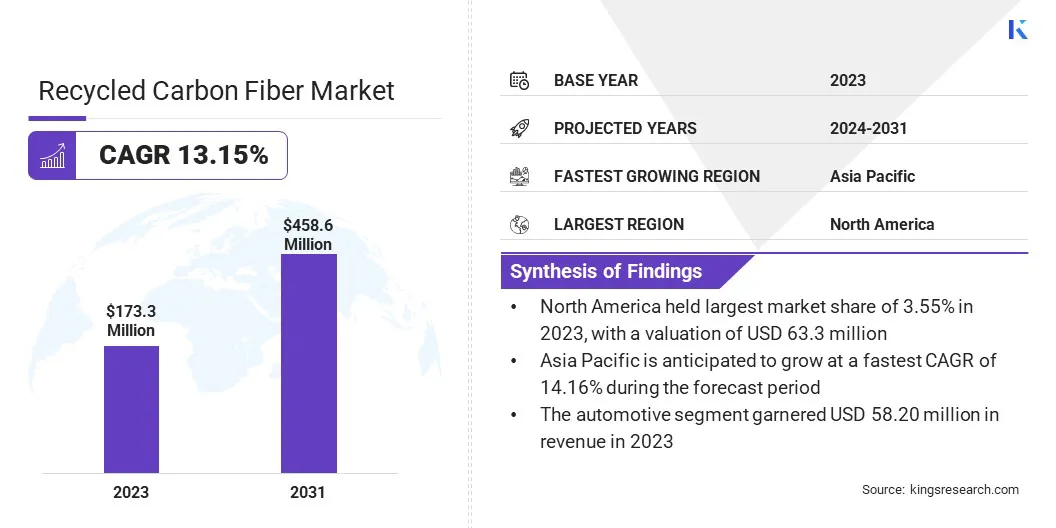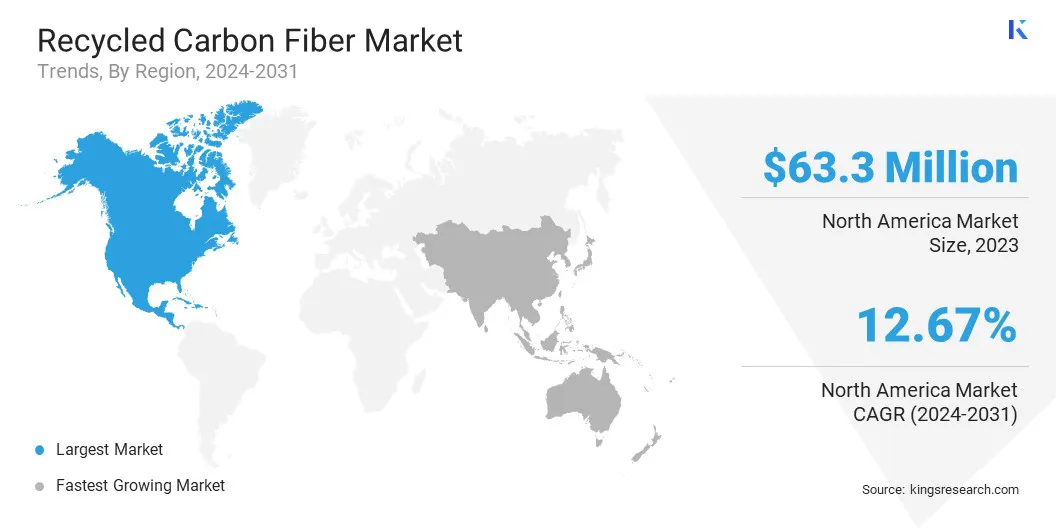Recycled Carbon Fiber Market Size
The global recycled carbon fiber market size was recorded at USD 173.3 million in 2023, which is estimated to be USD 193.1 million in 2024 and projected to reach USD 458.6 million by 2031, growing at a CAGR of 13.15% from 2024 to 2031.
The demand for lightweight materials across the automotive, aerospace, and sports equipment industries is boosting the market. Carbon fiber’s high strength-to-weight ratio makes it ideal for applications requiring durability and efficiency. In the scope of work, the report includes products offered by companies such as Vartega Inc., Sigmatex, Carbon Conversions, Procotex, Carbon Fiber Recycling, Teijin Limited, Toray Industries, Inc., Mitsubishi Chemical Inc., Gen 2 Carbon Limited, Thermolysis Co., Ltd., and others
Moreover, the cost-effectiveness of recycled carbon fiber compared to virgin carbon fiber is driving its widespread adoption. The high production costs associated with virgin carbon fiber often limit its use to premium applications, such as aerospace and high-performance automotive parts. Recycled carbon fiber offers a more affordable alternative without compromising on strength and performance, making it accessible for a broader range of industries.
Recycled carbon fiber refers to carbon fiber that has been recovered and repurposed from end-of-life products or manufacturing waste, rather than being produced from raw materials. The recycling process typically involves methods such as pyrolysis, solvent-based techniques, or mechanical grinding to break down carbon fiber composites and separate the fiber from the resin or matrix.
This recovered carbon fiber retains much of its original strength and performance characteristics, making it suitable for use in a wide range of industries. Recycled carbon fiber offers a more sustainable, cost-effective alternative to virgin carbon fiber while reducing environmental impact.

Analyst’s Review
Environmental sustainability has become a key focus for industries looking to reduce carbon footprints and adhere to strict regulations. Recycled carbon fiber plays a pivotal role in minimizing waste and supporting circular economies by reusing valuable resources. Governments globally are implementing regulations that encourage the use of recycled materials, creating favorable conditions for the growth of this market.
- In July 2023, the Union Cycliste Internationale (UCI) joined the award-winning Carbon Fibre Circular Alliance to combat the environmental impact of carbon fiber use. The alliance is focused on reducing waste and pollution while fostering cross-sector collaborations for circular innovation. This partnership aligns with the UCI Agenda 2030, which prioritizes sustainable development and addresses the challenges posed by climate change.
Manufacturers are increasingly turning to recycled carbon fiber to meet sustainability goals and comply with rising environmental standards. This shift aligns with ecological responsibility and accelerates the adoption of recycled carbon fiber, thereby propelling the market's expansion.
Recycled Carbon Fiber Market Growth Factors
The aerospace and aviation industries have long relied on carbon fiber composites for their superior strength and lightweight properties, which is fueling the market. Recycled carbon fiber is gaining traction within these industries as manufacturers look for more sustainable materials while maintaining performance standards.
The high cost of virgin carbon fiber makes recycled alternatives an attractive option for both structural components and interior parts of aircraft. Moreover, investments and funding play a crucial role in the global growth of the recycled carbon fiber market. Significant capital flows into the development of advanced recycling technologies and infrastructure to meet the rising demand for sustainable materials.
Venture capital, government grants, and private investments are driving innovation in recycling processes that improve the quality and efficiency of recycled carbon fiber.
- In June 2024, Climate Tech Nova Carbon secured USD 1.05 million in funding for its technology that facilitates carbon fiber recycling. This capital will support the transition from the laboratory phase to a pre-industrial study phase, with the goal of reducing non-recycled carbon fiber waste in France and Europe by 50% within the next ten years.
These investments accelerate technological progress, expand market adoption, and strengthen the role of recycled carbon fiber in the circular economy.
Recycled Carbon Fiber Market Trends
The sports and recreation sectors are increasingly integrating recycled carbon fiber into high-performance products such as bicycles, tennis rackets, and sporting equipment. The material's lightweight, high-strength properties enhance the performance of these products, offering athletes superior durability and agility.
With sustainability becoming a key consideration for consumers, sports manufacturers are turning to recycled carbon fiber to meet eco-conscious demands while still delivering top-quality performance. This growing trend toward environmentally-friendly materials is driving the demand for recycled carbon fiber within the sports and recreation industries.
Additionally, advancements in recycling technologies have significantly improved the efficiency and quality of recycled carbon fiber, boosting its market growth. Innovations in chemical recycling processes have enhanced the recovery of carbon fibers from end-of-life composite products, resulting in higher yields and better material properties.
- For instance, a research team at the Korea Institute of Science and Technology (KIST) developed an innovative recycling technology to address the waste disposal challenge of carbon fiber reinforced plastics (CFRP). This technology utilizes water in a supercritical state, achieved under precise temperature and pressure conditions, enabling the recycling of over 99% of CFRP materials in a short period.
These technological improvements are making it increasingly feasible for industries to integrate recycled carbon fiber into their manufacturing processes. The ability to produce high-quality recycled carbon fiber is helping to expand its applications and is driving growth across automotive, aerospace, and industrial manufacturing sectors.
Segmentation Analysis
The global market is segmented based on type, end use industry, and geography.
By Type
Based on type, the market is segmented into chopped recycled carbon fiber and milled recycled carbon fiber. The chopped recycled carbon fiber segment led the recycled carbon fiber market in 2023, reaching a valuation of USD 101 million.
Chopped carbon fiber is highly valued in the automotive, aerospace, and construction industries for its ability to reinforce composite materials, offering strength and durability at a lower cost compared to virgin carbon fiber. The increasing demand for lightweight materials in automotive manufacturing, particularly for electric vehicles (EVs), is driving the adoption of chopped recycled carbon fiber.
By End Use Industry
Based on end use industry, the market is classified into automotive, aerospace and defense, wind energy, sports and leisure, construction, and others. The automotive segment secured the largest revenue share of 33.58% in 2023, due to the increasing demand for lightweight, high-strength materials aimed at improving fuel efficiency and reducing emissions.
Recycled carbon fiber offers a cost-effective and sustainable alternative to virgin carbon fiber, aligning with the automotive industry's push toward sustainability. As automakers work to meet stricter environmental regulations and consumer preferences for eco-friendly vehicles, the adoption of recycled carbon fiber for parts such as body panels, interior components, and structural elements is rising.
Recycled Carbon Fiber Market Regional Analysis
Based on region, the global market is classified into North America, Europe, Asia Pacific, Middle East & Africa, and Latin America.

The recycled carbon fiber market in North America accounted for a share of 36.55% in 2023 in the global market, with a valuation of USD 63.3 million. The growing automotive and aerospace industries in North America are significant drivers of demand for recycled carbon fiber. As these industries focus on reducing vehicle weight and improving fuel efficiency to meet regulatory standards, the need for lightweight, durable materials has surged.
Recycled carbon fiber provides a cost-effective and sustainable alternative to virgin carbon fiber, making it an attractive option for manufacturers in both sectors. The shift toward EVs and the need for lightweight materials to optimize battery efficiency further enhance the demand for recycled carbon fiber in North America.
- The Environmental Defense Fund's report, released in August 2024, projects that by 2027, U.S. EV manufacturing facilities will have the capacity to produce around 5.8 million new EVs each year. This would account for 36% of all vehicles sold in the U.S. in 2023.
Moreover, the adoption of circular economy principles in North America is significant driver of the market. Companies are increasingly looking for ways to close the loop on carbon fiber production by recycling end-of-life products.
North American manufacturers are actively exploring ways to incorporate recycled carbon fiber into their supply chains, reducing their reliance on virgin materials and contributing to the expansion of the market in the region.
The recycled carbon fiber market in Asia Pacific is poised for significant growth at a robust CAGR of 14.16% over the forecast period. Technological innovations in carbon fiber recycling and manufacturing processes are driving the market growth in Asia Pacific. Advanced recycling technologies, such as pyrolysis and solvent-based methods, are enabling the recovery of high-quality recycled carbon fiber from end-of-life products and waste materials.
Additionally, the integration of automation and digital technologies in manufacturing processes is improving the efficiency of recycled carbon fiber production. These advancements are making recycled carbon fiber more accessible, cost-effective, and scalable for use in a variety of applications across the region.
Additionally, various sectors such as automotive, sports, and electronics are increasingly incorporating recycled carbon fiber to meet growing consumer expectations for environmentally responsible products. The rising demand for sustainability is thus helping to propel the market for recycled carbon fiber in the region.
Competitive Landscape
The global recycled carbon fiber market report will provide valuable insights with an emphasis on the fragmented nature of the . Prominent players are focusing on several key business strategies such as partnerships, mergers and acquisitions, product innovations, and joint ventures to expand their product portfolio and increase their market shares across different regions.
Strategic initiatives, including investments in R&D activities, the establishment of new manufacturing facilities, and supply chain optimization, could create new opportunities for market growth.
List of Key Companies in Recycled Carbon Fiber Market
- Vartega Inc.
- Sigmatex
- Carbon Conversions
- Procotex
- Carbon Fiber Recycling
- Teijin Limited
- Toray Industries, Inc.
- Mitsubishi Chemical Inc.
- Gen 2 Carbon Limited
- Thermolysis Co., Ltd.
Key Industry Developments
- July 2024 (Product Launch): Thermolysis Co. Ltd., launched a new brand called RCF for the development of recycled carbon fiber (rCF) products. This initiative includes the design of various bike accessories and everyday items made from carbon fiber that is regenerated through a thermolysis process.
- December 2023 (Product Innovation): Teijin Limited announced the production of Tenax Carbon Fiber using sustainable acrylonitrile (AN) derived from biomass and recycled materials. The new Tenax Carbon Fiber maintains the same physical properties and performance characteristics as its fossil-based counterparts, enabling seamless adoption by customers aiming to reduce greenhouse gas emissions throughout the product lifecycle.
The global recycled carbon fiber market is segmented as:
By Type
- Chopped Recycled Carbon Fiber
- Milled Recycled Carbon Fiber
By End Use Industry
- Automotive
- Aerospace and Defense
- Wind Energy
- Sports and Leisure
- Construction
- Others
By Region
- North America
- Europe
- France
- UK
- Spain
- Germany
- Italy
- Russia
- Rest of Europe
- Asia Pacific
- China
- Japan
- India
- South Korea
- Rest of Asia Pacific
- Middle East & Africa
- GCC
- North Africa
- South Africa
- Rest of Middle East & Africa
- Latin America
- Brazil
- Argentina
- Rest of Latin America


